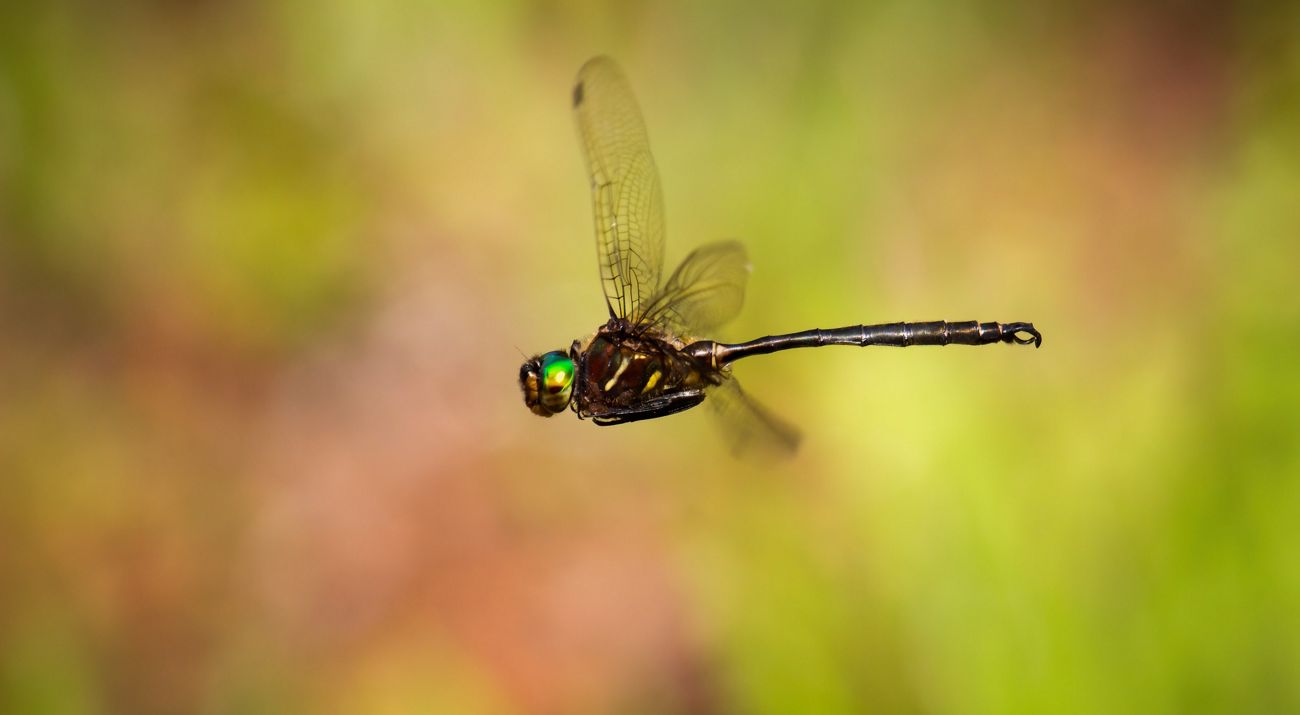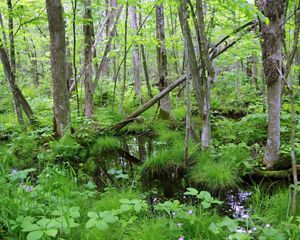Rare Dragonfly Gets a Helping Hand
Research and technology help reveal the mysteries of the Hine’s emerald
Donate Today
Your support helps us protect habitat for rare dragonflies, birds and many other animals.
Donate to WisconsinIn July, Dr. Dan Soluk, researcher Lauren Morris and assistant Naomi Bingham made their annual trek to Mud Lake State Wildlife Area in Door County, carrying long nets and watching the sky for the nightly hunting voyage of the Hine’s emerald dragonfly. Trained eyes searched the airspace above a dry meadow for the federally endangered species’ large bodies and striking green eyes, using careful swings to capture them mid-air. Males are quickly released, but females get a quick dip in a small cup of water, where they instinctually release their eggs.
Those eggs are collected for use in Dr. Soluk’s laboratory, back at the University of South Dakota, where work is ongoing to study the genetic diversity and resilience of the Door County population. The data will help scientists and conservationists determine the best next steps for helping the species survive in a changing world.
The study is just the latest step in decades of research and conservation work since the dragonfly, once believed to be extinct, was rediscovered in 1987 at The Nature Conservancy (TNC)'s Mink River Preserve in Door County. TNC is protecting groundwater recharge areas important to the dragonfly’s larvae, which may be the key to the species’ survival.
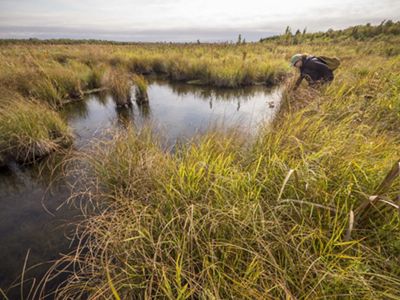
A Technological Game of Hide and Seek
Did you know that COVID tests can be used to track dragonflies, too? The same technology used to identify the virus—called a QPCR test—can be used to sniff out traces of DNA in the natural environment from all kinds of living things, including dragonflies.
In addition to the egg collection work, Dr. Soluk and his team are developing the use of that environmental DNA (called eDNA) to locate habitats where the dragonflies are most prevalent. This sort of targeted sleuthing will mean more efficient use of precious resources, allowing fewer people to get more work done in less time. In a place as large as Door County, that’s essential.
“The nice thing about eDNA is the fact that you can just sample the water,” says Soluk. “We’ve had people walk through the upper part of the Mink River watershed looking for potential habitats, small streamlets that are flowing, and it's a lot of acres to cover. It takes a crew of four the whole summer just to find those spots before we can take our samples.”
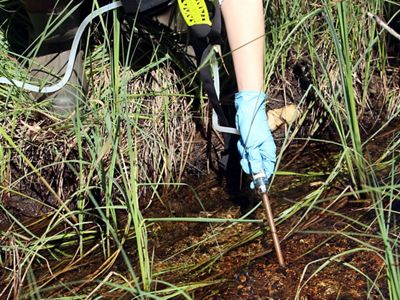
Researcher Lauren Morris uses a pump tool to test for eDNA in a small streamlet where the Hine’s emerald dragonflies are known to breed and lay eggs.
Unlike other animals, however, insects don’t tend to shed much of their DNA. Soluk explains that seasonality has proven to be important. Finding those times of year when the dragonflies are more likely to be molting or dying makes the eDNA easier to find because it is detectable farther away from the source.
“We are trying to develop protocols that we can pass on to groups like the U.S. Fish and Wildlife Service, so that eventually they could apply them and have some sense of when to sample for best results,” adds Soluk.
All of this is in the hopes of calculating a more precise count of the existing population.
“The numbers are important, because although it's a big population now, it doesn't ensure that it's going to be a big population in the future. We’d rather know that their numbers are declining instead of discovering one day that they're not here anymore,” Soluk says. “If your criteria are, ‘there's lots and then there's none,’ then that's not a very good way to understand or to help conserve the species.”

Dr. Dan Soluk gently holds a female Hine’s emerald dragonfly between his fingers.
Importance of Door County for Hine’s Emerald Dragonflies
Soluk's partnership with TNC in Wisconsin is just one example of how TNC both facilitates scientific study and uses the findings to inform its work.
“The Hine's emerald plays a big part in our work here in Door County,” says Mike Grimm, conservation ecologist with TNC Wisconsin. “Because it depends on clean groundwater to survive, we’re protecting the groundwater flowing toward the wetlands it utilizes. We also consider the presence of this endangered species whenever we plan management work in the wetlands where it lives.”
TNC owns a little over 4,700 acres in Door County, split between four different preserves, all of which are home to Hine's emeralds. Door County hosts, in fact, the greatest abundance of this endangered dragonfly in the world.
Door County Preserves Where Hine’s Emerald Occurs
Prior to the species’ rediscovery, little was known about the 2.5-inch-long insect. But Soluk and his students are changing that.
Soluk's research base is a TNC cabin at Mink River Preserve. Having this facility for his students to use during the summer makes the research possible, he says. “One of the most difficult things when you're doing science at remote locations is the cost of accommodations.”

Into the Predator’s Lair
The Hine's preferred habitat is groundwater-fed wetlands over dolomite or limestone bedrock, creating slightly alkaline water. Their maturation process from egg to dragonfly lasts four to five years, much longer than that of most dragonfly species, and is one of the reasons the species is endangered.
The dragonfly also occupies a unique niche, adapted to survive long periods in dry conditions, as the spring-fed streamlets in these wetlands dry up each summer. Hine's emerald larvae reserve their energy stores through the dry periods, as well as the winter, by hiding out in crayfish burrows, Soluk explains.
It would seem an unlikely solution, seeing as crayfish are known to prey upon the larvae. “You basically have an animal that you want to conserve that requires the presence of one of its predators,” Soluk says.
“[It's] a really interesting way to understand how ecosystems work...” he says. “If we want to maintain their integrity, we've got to think about not just the simple needs that we might envision for the species, but the complicated interactions that are occurring on many levels.”
It's still not known exactly how enough Hine's larvae avoid being eaten in the burrows. One theory, studied by one of Soluk’s grad students, is that the dragonfly’s hairiness, which likely helps it conserve water, also collects material such as feces, perhaps disguising its scent.
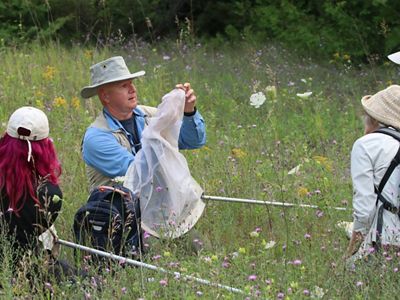
Dr. Dan Soluk carefully retrieves a Hine’s emerald dragonfly from a net in order to collect the females’ eggs to study the genetic diversity and resilience of the Door County population.
Quote: Mike Grimm
The Hine’s emerald plays a big part in our work here in Door County. Because it depends on clean groundwater to survive, we’re protecting the groundwater flowing toward the wetlands it utilizes.
Threats to the Hine’s Emerald Dragonfly
Among the major threats to the Hine's emerald are groundwater contamination and depletion, especially from nearby development. “When you have a wetland area, it’s important to protect not only that wetland but those areas that provide groundwater to the wetland. And that can be a big area,” Soluk says.
Bringing attention to the species is a way to get people thinking about the larger systems that they—and we—need to survive. “I think people can relate to an animal better than to the hydrology of groundwater movement,” Grimm says. Besides providing crucial habitat for the Hine’s, he explains, TNC works with area stakeholders to protect groundwater resources, which also provide well water for people.
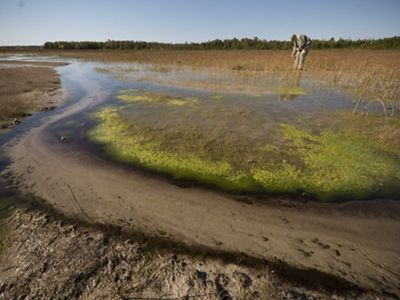
With regulatory protections on the decline both at the state and national level, it’s more important than ever for conservation groups like TNC to protect unique habitats, like groundwater-fed wetlands.
“If you look at an adult Hine's emerald, it’s a beautiful creature that has been around for maybe a million years. And its relatives have been around for 300 million years,” Soluk says. This species has intrinsic value worthy of protection, he says. And in understanding and protecting what this unique species needs to survive, we also protect the water we need for our own survival.
More Wisconsin Nature News, straight to your inbox
Keep in touch with TNC's work in Wisconsin.
